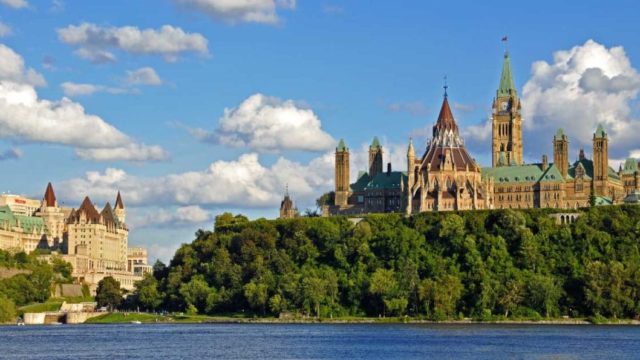Global pandemic illustrates importance of legislating the right to a healthy environment
Wearing a face mask, repeatedly washing our hands and maintaining a two-metre distance when encountering others is now part of our daily routine.
Due to the spread of coronavirus, we have never been more acutely aware of how our environment impacts our health. But the law that is supposed to protect our environment and health is seriously out of date.
The UN Office of the High Commissioner for Human Rights states that a “safe, clean, healthy and sustainable environment is integral to the full enjoyment of a wide range of human rights, including the rights to life, health, food, water and sanitation.” In short, the right to a healthy environment is a human right.
The Canadian Environmental Protection Act (CEPA), the law intended to uphold and protect the health of Canadians by securing a healthy environment hasn’t been updated in 20 years. It has also never included the right to a healthy environment. The Act, as it stands, does not recognize the interplay between a healthy environment and the fulfilment of human rights.
When the Liberals were returned to office in the fall of 2019, they committed to strengthen CEPA to better protect people and the environment from toxic substances and other pollution. That commitment came as a result of a years-long effort by Ecojustice and our partners at the David Suzuki Foundation, Environmental Defence and MakeWay to ensure the government updates CEPA into the strongest possible legislation.
A strong CEPA must include the right to a healthy environment. We are not the only people to make this argument. The parliamentary committee that reviewed CEPA in 2017 recommended that the government consider amending the Act to include the right to a healthy environment. This group of politicians recognized that without it, CEPA is no longer fit for the 21st century.
Minister Jonathan Wilkinson and his Parliamentary Secretary, Peter Schiefke, are currently developing their plans to modernize CEPA, and we hope to see a bill with updates to the legislation tabled later this year. Ecojustice has made several recommendations to the Minister about what we believe should be in this bill – and a core ask is the meaningful inclusion of a right to a healthy environment. But we need your support.
Real risks to real people
There are, unfortunately, countless instances of how CEPA has failed Canadians and left real people exposed to real risks.
Some Indigenous communities live with dangerously high levels of pollution. Harmful chemicals, such as flame retardants used in furniture and electronics, PFAS used in food packaging, and petrochemicals used in plastics and personal care products can put Canadians’ health at risk.
An updated CEPA that includes the right to a healthy environment matters because it will strengthen how our decision-makers assess and regulate chemicals and apply the policies they introduce.
In Ontario, the Aamjiwnaang First Nation is located in an area of Ontario that has become known as Chemical Valley. The sprawling industrial complex, with a cluster of petroleum refineries, petrochemical plants, and energy facilities, pumps out pollution into the air that results in pollution levels higher than almost anywhere else in Canada.
Toxic pollution inflicted on the Aamjiwnaang First Nation and others who live in the vicinity of Chemical Valley has real and lasting consequences. A study published in 2019 found strikingly high rates of cancer linked to exposure to benzene, a petrochemical measured at elevated concentrations in the air of communities adjacent to Chemical Valley’s plants.
One step the federal government can take right now to correct some of the injustices Aamjiwnaang First Nation continues to experience is to enshrine the right to a healthy environment in CEPA.
Pollution and COVID-19
Health Canada estimates that 14,600 deaths are caused by air pollution each year in Canada. Studies also suggest that exposure to air pollution is linked to higher COVID-19 cases and deaths. Early studies from Harvard University have found that those who contract COVID-19 in more polluted areas are more likely to die than those who live in less polluted areas.
Poor and racialized communities are those who suffer the worst. New data shows that of all COVID-19 cases in Toronto between May 20 and July 16, 83 per cent involve members of racialized communities. More than 50 per cent of the cases reported in the city were from households with an income of $50,000 or less. And we already know pollution in Toronto disproportionately impacts poorer, BIPOC communities.
Environmental injustice is persistent beyond big cities too. Dr. Ingrid Waldron of Dalhousie University studies environmental racism in Canada. In her book, There’s Something In The Water: Environmental Racism in Indigenous and Black Communities, she writes about the toxic legacy that industrial facilities, deliberately located next to low-income, Indigenous and Black communities, have had across Nova Scotia.
Better than normal means a right to a healthy environment
The federal government needs to bring CEPA into the 21st century and legislate the right to a healthy environment to protect Canadians, especially those in vulnerable situations, from environmental pollution.
As the country attempts to rebuild from the pandemic – Canadians are looking for a future that is better than normal. This includes ensuring that our laws protect all Canadians from dangerous pollution that impacts our health and the air, water and land we all depend on.
As Minister Wilkinson looks to update CEPA, he must bring Canadian legislation into line with the majority of nations around the world. 155 countries have legal obligations to respect, protect and fulfil the right to a healthy environment. It is beyond time for Canada to join their ranks by reforming CEPA to, among other things, recognize your right to a healthy environment.




